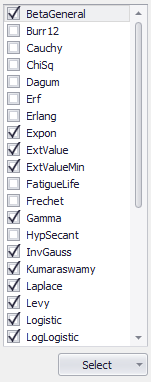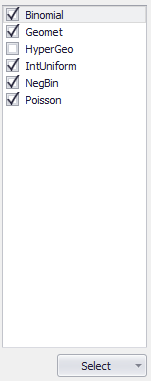Selecting Distributions
When selecting distributions to test for fitting, there are three configurations that control the list of available distributions; the Fit Data Types setting, the Lower Limit selection, and the Upper Limit selection. Use these three settings to filter the list of distributions to match the characteristics of the data set.


Figure 1 - Continuous vs. Discrete
The first setting that controls the list of distributions is the Data Type setting, found on the Data tab. The selection made for this option will generally limit the list of distributions to either continuous or discrete (Figure 1, right).
After selecting the data set type, the list of distributions can be restricted further by selecting the characteristics of the lower and upper bounds; these are set in the Lower Limit and Upper Limit sections. Both sections include the same options:
The Lower Limit and Upper Limit options are only available when the Data Type is set to 'Continuous Sample Data', 'Density (X,Y) Points' (Unnormalized and Normalized), and 'Cumulative (X,P) Points' options.